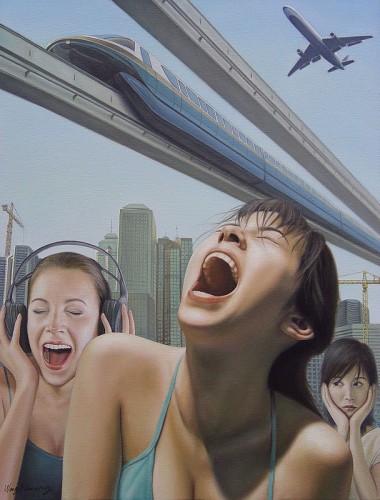
Forgotten Garden, 1986–89, Wang Huaiqing,
The political is everything (particularly if you’re a New York Times correspondent) when reporting on China. It is the air Chinese artists, poets, not to mention mere citizens, breathe every day. Yet with this reified fact comes clearly the desire to find a non-political space, a sense of “freedom”. Yet the ambivalence in this desire emerges just as quickly and directly against the draw of the political. When the ideological gravity recedes or is effectively evaded, or when the political blast from State media, ideologically inclined friends, family and random strangers somehow falls silent, we often find that the would-be escapee from China’s political atmosphere often comes back to the fold. What draws the artist (broadly writ) to the political is, I think, the association between politics and China, the Chineseness of the expression is, in other words, its rootedness in political condition without which one is not a “Chinese artist” but, merely, an artist, a more difficult positionality in most respects. To put it this way seems already a bland observation, though, in perhaps the same way that an Chinese artist devoid of political import seems in some sense vapid. The speciousness of the dichotomy then presents itself as well, as the divergence cannot ‘really’ be between freedom, a mere abstraction, and nation, in many ways also abstract. The glocality of a given Chinese artist is closer to home than that. Thusly paradoxical: the closer the artist to home (provincial, city-level, prefecture and so on) the more aptly launched into political discourse (and back).
That, unless you’re Wang Huaiqing painting “5000 Years”. Robert Ayers, in his description of Wang Huaiqing’s exhibition in Seattle (SAAM) for Huffington Post, points to the non-political as an important element in exhibition, one transcends a more limited frame of reference. As Ayers has it:
The political and economic history between Mao’s infamous cultural revolution and present-day China’s overeager capitalism provides a recurrent touchstone in their art’s imagery. In fact this shared material is so common that it provides a handy starting point for a comprehension pretty much any contemporary Chinese art.
Wang Huaiqing, by contrast,
If there wasn’t any meaning in art, then we wouldn’t really need it.” The meaning in Wang Huaiqing’s art is nothing less than the entire history of Chinese culture. I cannot think of another artist east or west who is attempting anything quite so ambitious right now. That alone makes this Seattle show too important to miss.
In my response to Ayers I note that many, from XU Bing to Wenda GU and others, have been at least as ambitious. In fact, the entire Root-Seeking phenomenon more or less conforms to what Ayers is describing. Perhaps the difference is between what artists (writers, etc) intend to accomplish and what they accomplish in fact.










